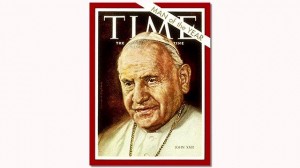“We are called to establish with truth, justice, charity, and liberty new methods of relationships in human society.” So states Pope John XXIII’s seminal encyclical Pacem in terris (PT), which celebrates its 50th Anniversary this year. A variety of Catholic media outlets have capitalized on the anniversary to highlight some of the encyclical’s enduring hallmarks. Likewise, universities and peace-building organizations have hosted international conferences on the topics of war and peace. Notre Dame’s recent “Peace Yesterday, Today and Tomorrow” conference was one such gathering, which I was fortunate to attend. The conference aimed at facilitating an international, interfaith exploration of thematic peace and justice issues, especially those emerging in PT. I share a few reflections on the conference here.
The call to “establish truth, justice, charity and liberty” aptly captures a core conviction shared by the conference’s diverse presenters and attendees. Laity, clergy, Muslims, Christians, Westerners, Easterners, academics and practitioners, all brought experience working at a particular level of global society to promote peace, reconciliation efforts and conflict resolution. Those I encountered certainly merited the moniker a fellow attendee used for them: “artisans of peace.” Rather than a strict reading of PT in light of its historical context, speakers impressed me with their astute applications of its content to 2013 “signs of the times.” Worthy of particular mention were Fr. Paul Kollman’s insights about the tremendous power for today’s technologies, even as they accelerate human works, to displace human dignity. They can also result in our “ethical deskilling,” he argued, evidenced in the operation of drones in the Middle East from remote U.S. operating centers. With such technologies, “our ethics muscles become atrophied,” even as drone-operators sit at a computer in the comfort of an Arizona office building.
One of the conference’s aims in inviting speakers from around the world was to acknowledge that an international and interfaith approach to peacemaking and the promotion of human rights has profoundly affected Catholic teaching and practice. It is not surprising, then, that many presenters focused on human rights as a key feature of PT. In his keynote, Fr. Kenneth Himes spoke of human rights as PT’s “backbone.” And while PT presents a distinctively Catholic approach to peacemaking, he attributed to it the fact that rights language became common parlance in Catholic discourse, especially when appealing to non-Christian constituencies, as seen in the addresses of Pope John Paul II. As Himes put it, the human rights articulated in PT provide the “frame” around a canvas on which pluralist societies could paint particular patterns of governance.
Other speakers offered creative applications of PT’s principles to “signs of the times” not readily associated with peace-building. Most memorable was a talk by Peter Jeffrey, entitled, “Can CST bring peace to the Liturgy Wars?” Jeffrey proposed PT’s principles as a warrant against antagonism amongst liturgists and parishioners over particular Catholic liturgical practices. He pointed especially to PT’s respect for the right of the other to worship according to their conscience and its ideas about the right to culture, both possible warrants for accomodating others in parish settings.
A joint presentation by Margarita Rose and Rodrigo Gereda of the Interfaith Resource Center for Peace and Justice (IRCPJ) was also thought-provoking. Rose and Gereda discussed the challenge to IRCPJ, founded by a group of interfaith community activists, posed by the organization’s changing leadership and membership demographics. With an increase in non-religious members, the organization is negotiating the fact that some of its newer partners are apprehensive of the use of Christian principles and/or language in organizational statements, documents, meetings, etc. I was encouraged by Dr. Rose’s sense of the twin need to dialogue with such partners and to safeguard the unique resources faith-based organizations can contribute to peace efforts. Furthermore, faith-based organizations with non-religious members can and should model in their internal operations the peaceful cooperation and dialogue they promote at the global level.
The most powerful among the lectures I attended was undoubtedly the 2013 Archbishop Oscar Romero Lecture offered by Julian Filochowski, entitled, “The Martyrdom of an Apostle for Peace and Vatican II Champion Challenges Us.” He told the story of this humble archbishop and champion of peace, a man who lived and breathed a “theology of the Beatitudes,” in a way only someone who knew Romero personally could have. Romero became the untiring champion of El Salvador’s poor, drawing from the Gospel and the documents of Vatican II as his intellectual and moral wellspring, both of which were practically “in his bloodstream.” Filochowski made real Romero’s prophetic challenge even vis-à-vis PT itself, such that the “cleavage” PT saw between faith and practice was more accurately depicted by Romero as a “chasm,” especially in the lives of privileged Catholics in El Salvador and abroad. It was this “chasm” that Romero ultimately laid down his life to bridge. Playing an audio recording of the moments leading up to Romero’s assassination, Filochowski captured a unity of “orthodoxy” and “orthopraxis” not only present in Romero’s theology, but in his personal witness, even in its final moments. Romero proved to be the “artisan of peace” by whom I left the conference most inspired.